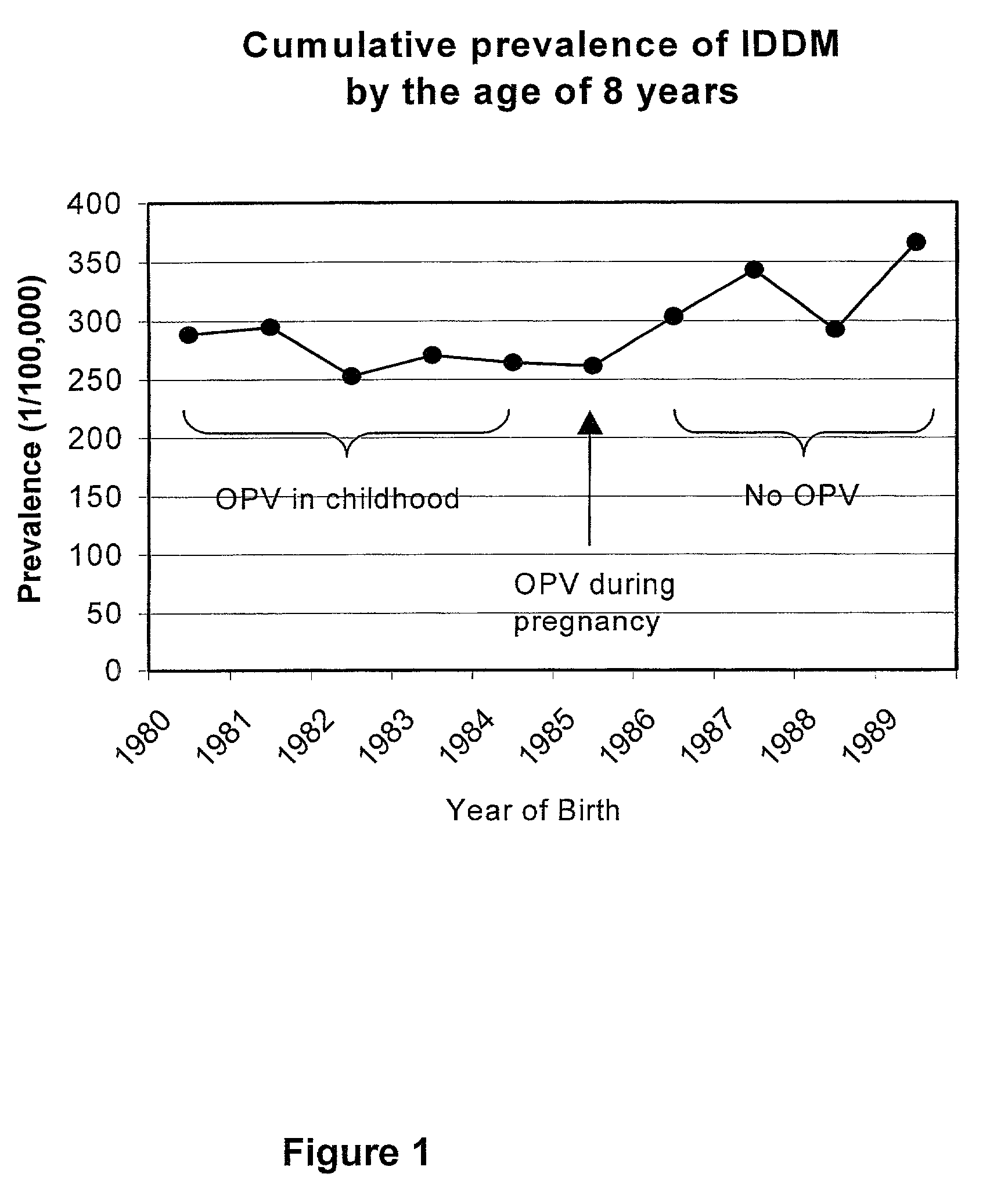Prevention of Type 1 diabetes and other non-polio enterovirus diseases
a type 1 diabetes and enterovirus technology, applied in the direction of positive-sense ssrna viruses, viral antigen ingredients, biochemistry apparatus and processes, etc., can solve the problems of ipv vaccine not protecting against poliovirus infection but only against infection complications, neutralizing antibodies, and induced local immune response in the gut. , to achieve the effect of avoiding harmful side effects and inducing serotype specific immunity
- Summary
- Abstract
- Description
- Claims
- Application Information
AI Technical Summary
Benefits of technology
Problems solved by technology
Method used
Image
Examples
example 1
[0059]We have analysed the effect of OPV vaccination on the course of subsequent coxsackievirus B3 (CBV3) infection in mice. In these studies we used a transgenic BALB / c strain which expresses human poliovirus receptor and can therefore be infected by human polioviruses (Horie et al., 1994).
[0060]Transgenic BALB / c mice were first immunized by live poliovirus vaccine (Sabin strain of poliovirus type 1) or inactivated poliovirus vaccine IPV, and later challenged to a pancreas-tropic strain of coxsackievirus B3 (Nancy strain). (IPV was the commercially available poliovirus vaccine Novum purchased by National Public Health Institute of Holland). Two doses of live poliovirus vaccine strain type 1 (Sabin) were given intramuscularly with two weeks intervals (106 TCID50 / mouse, first injection at the age of 8 weeks). Two doses of killed poliovirus vaccine were given intramuscularly in the same way (0.1 μg per mouse). Two weeks after the last poliovirus injection the mice were infected by cox...
example 2
[0068]We have produced and tested formalin-inactivated coxsackievirus B vaccines in mice. These vaccines were produced by inactivating sucrose gradient purified viruses by 14 days incubation at +37° C. in 0.01% formalin in PBS.
[0069]Mean IgG1 antibody levels against purified coxsackievirus B3 were determined in Balb / c mice immunized by 3 repeated intramuscular injections with formalin-inactivated coxsackievirus B3 vaccine or phosphate buffered saline (PBS). Injections were given with two weeks intervals (first one at 8 weeks of age) and antibodies were measured at 2 weeks after the last vaccination. Antibody levels are expressed as OD492 values in EIA (Table 4).
[0070]
TABLE 4Antibody levels induced by inactivated coxsackievirusB3 vaccine in miceImmunization groupPBSCoxsackievirus B3 vaccineSerum dilution(N = 5)(N = 5)1 / 16000.120.951 / 64000.130.47 1 / 256000.140.28
[0071]Presence of viremia (virus in serum) was determined in BALB / c mice immunized with three repeated intramuscular injectio...
example 3
[0075]SJL / J mice were first immunised either with formalin-inactivated poliovirus vaccine (IPV; 0.1 μg / mouse), or with saline (PBS). After 14 days the mice were infected with coxsackievirus B3 intramuscularly (106 TCID50 / mouse). Histopathology of the pancreas was analysed 14 days after the infection. The results are shown in Table 6.
[0076]
TABLE 6Inflammation reaction (T-cell infiltration) in thepancreas of SJL / J mice infected intramuscularly with a pancreas tropicstrain of coxsackievirus B3 (Nancy strain).VaccinePancreaticPBSIPVinflammation(N = 5)(N = 5)Strong14Moderate21Not detected20
[0077]Our observations indicate that IPV increases the severity of non-polio enterovirus infections. We have found that mice, which have first been immunized by IPV and later infected with a non-polio enterovirus, namely a pancreas tropic Nancy strain of coxsackievirus B3, had more severe pancreatitis than mice which had not previously been immunised with IPV (Table 6).
[0078]Mean IgG1 antibody levels a...
PUM
| Property | Measurement | Unit |
|---|---|---|
| Time | aaaaa | aaaaa |
| Time | aaaaa | aaaaa |
| Time | aaaaa | aaaaa |
Abstract
Description
Claims
Application Information
 Login to View More
Login to View More - R&D
- Intellectual Property
- Life Sciences
- Materials
- Tech Scout
- Unparalleled Data Quality
- Higher Quality Content
- 60% Fewer Hallucinations
Browse by: Latest US Patents, China's latest patents, Technical Efficacy Thesaurus, Application Domain, Technology Topic, Popular Technical Reports.
© 2025 PatSnap. All rights reserved.Legal|Privacy policy|Modern Slavery Act Transparency Statement|Sitemap|About US| Contact US: help@patsnap.com

